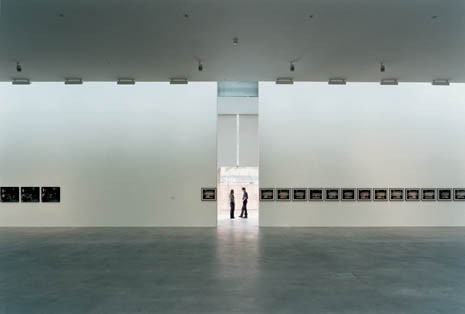Claudio Silvestrin’s new gallery for the Sandretto Re Rebaudengo Foundation in Turin puts art and architecture on equal terms. Stefano Casciani reports. Photography by Gabriele Basilico
A small cultural shock is a good thing every now and again. The last one I remember was probably six years ago, a Turin exhibition curated by Francesco Bonami and promoted by the then-new Sandretto Re Rebaudengo Foundation, strongly driven by Patrizia Sandretto. The show was called Campo 6 and, although they could not have forecast it then, it heralded the generation of new artists that today dominates the world’s most awkward and successful contemporary scene. From the literally terrible Chapman brothers, with their admonitory mutilations, to the populist brainwaves of Maurizio Cattelan and even the surprising dual-screen argument between two (probable) lovers by Sam Taylor Wood, the sequence of living ghosts that inhabited Turin’s GAMC remains an indelible memory.
Claudio Silvestrin seems very familiar with this side of today’s art – its despotic absolutism, its aspiration to become a world unto itself, its tendency to repeat the real tale of existence with the appropriate distortions, so that it becomes both spectacle and commerce. Silvestrin has learned the lessons of his one-time teacher AG Fronzoni, so when a competition was announced in 1999 by the Sandretto Re Rebaudengo Foundation for a building to house art and related cultural activities in the not always easy city of Turin, Silvestrin won the commission to design a totally new building on an already productive site, where a small factory had for many years provided jobs for workers living in the San Paolo neighbourhood. When the area became available for the project that the foundation wanted to create, the characteristic conflicts ensued. High culture and local politics came into conflict and succeeded in blocking construction for some time.
Silvestrin’s solutions are apparently as simple as the context was complex. An intentionally simplified form, a long shed, as defined by the designer in his competition entry, is developed on the horizontal, dictated by the need for the intelligent control of the routine operations of a museum or art gallery. This pragmatic sensitivity must have caught the eye of Patrizia Sandretto, chair of the foundation, and that of Francesco Bonami, then a member of the competition jury and now the foundation’s director and the recently appointed director of the next Venice Art Biennale. The far from loquacious Bonami conceals an ability to manage decision processes, seize opportunities and identify people capable of creating space for works in almost total freedom. In this Bonami is extremely democratic and very American, as he has lived for many years in Chicago.
It must have seemed impossible to discover at last, among the many, an architect who was not out to erect a personal monument to himself or to his client. Yet, following the long perspectives of this construction in time, from building site to completed work, pausing to dwell on every detail and witness the material outcome of the ideas, the knowledgeable visitor will clearly understand that artists and their perversions take on new meaning in a structure and place that have in themselves an objective artistic connotation. Not because the slender apertures in the front allow blades of light to pass through and mark the long rhythm of the facade; not because the smooth Lecce stone surface allows the strange light of the Turin sky to slide over it, changing colour and shade from grey to blinding turquoise; nor even because the space itself, seemingly so immense and open in the giant exhibition hall, becomes a maze in the functional areas, with domestic overtones in the most convivial parts of its architecture. Silvestrin’s work draws instead on the idea of art because the building, as a whole, seems to cry out for – as a need – the supremacy of the construction over the setting, of content over form, of acting over describing.
Contemporary art, which when it acts also narrates, imitates and plays a consciously false role, cannot make objective changes to the human condition – except on those rare occasions when it encounters and acts with and in the architecture. So, like the visitors from all over the world who will want to see the first true centre for contemporary art created in Italy after decades of public and private inertia, the people living in the neighbourhood where the building is now embedded will also be able to enter and love or scorn (but not ignore) the art that will be contained there.
This may unleash their indifference and aversion or give them more beneficial surprises, but the architecture housing it will nonetheless be the setting for democratic culture, to which all are admitted on the condition that they respect its rules. Only the artists are allowed to cheat; from them we may expect many ‘falsehoods that tell the truth’.
Purism in the suburbs

View Article details
- 15 July 2002